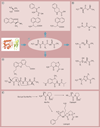Peptides and peptidomimetics as immunomodulators
- PMID: 25186605
- PMCID: PMC4201125
- DOI: 10.2217/imt.14.37
Peptides and peptidomimetics as immunomodulators
Abstract
Peptides and peptidomimetics can function as immunomodulating agents by either blocking the immune response or stimulating the immune response to generate tolerance. Knowledge of B- or T-cell epitopes along with conformational constraints is important in the design of peptide-based immunomodulating agents. Work on the conformational aspects of peptides, synthesis and modified amino acid side chains have contributed to the development of a new generation of therapeutic agents for autoimmune diseases and cancer. The design of peptides/peptidomimetics for immunomodulation in autoimmune diseases such as multiple sclerosis, rheumatoid arthritis, systemic lupus and HIV infection is reviewed. In cancer therapy, peptide epitopes are used in such a way that the body is trained to recognize and fight the cancer cells locally as well as systemically.
Keywords: T-cell epitope; cyclotide; immunomodulation; peptide-based vaccine; peptidomimetics; β-amino acid.
Conflict of interest statement
Financial & competing interests disclosure
The authors have no other relevant affiliations or financial involvement with any organization or entity with a financial interest in or financial conflict with the subject matter or materials discussed in the manuscript apart from those disclosed.
No writing assistance was utilized in the production of this manuscript.
Figures







References
-
- Springer TA. Adhesion receptors of the immune system. Nature. 1990;346(6283):425–434. - PubMed
-
-
Chen L, Flies DB. Molecular mechanisms of T cell co-stimulation and co-inhibition. Nat. Rev. Immunol. 2013;13(4):227–242. •• This review article provides overview of cell adhesion molecules and their importance in immune response.
-
-
- Jois SD, Jining L, Nagarajarao LM. Targeting T-cell adhesion molecules for drug design. Curr. Pharm. Design. 2006;12(22):2797–2812. - PubMed
-
-
Balague C, Kunkel SL, Godessart N. Understanding autoimmune disease: new targets for drug discovery. Drug Discov. Today. 2009;14(19–20):926–934. • Provides a good background for the readers regarding immune response and strategy for drug design.
-
-
-
Larche M, Wraith DC. Peptide-based therapeutic vaccines for allergic and autoimmune diseases. Nat. Med. 2005;11(4 Suppl.):S69–S76. • Provides the details of peptide-based therapeutics for autoimmune diseases.
-
Publication types
MeSH terms
Substances
Grants and funding
LinkOut - more resources
Full Text Sources
Other Literature Sources
Medical
